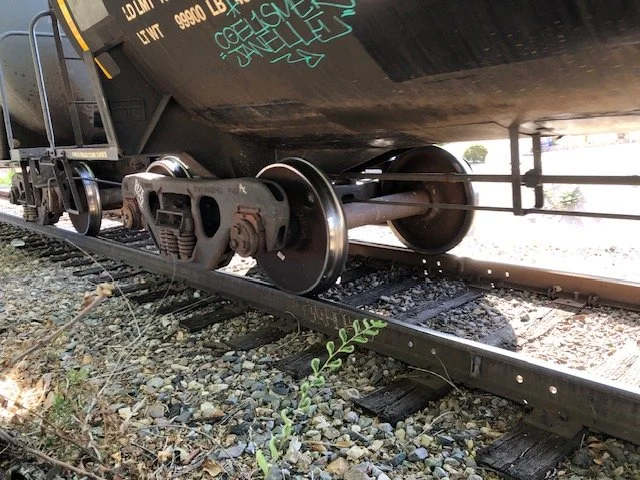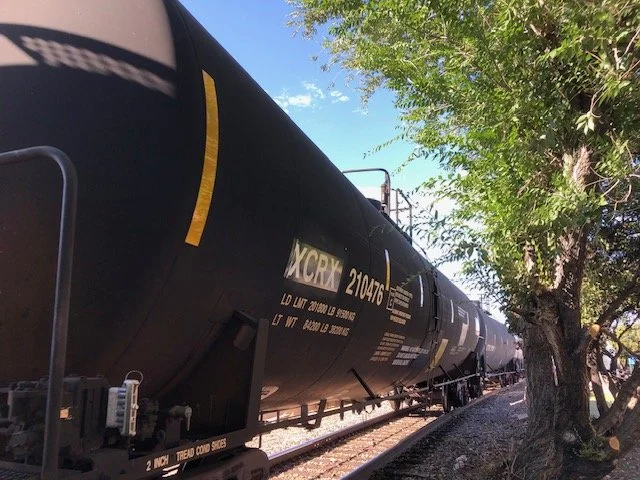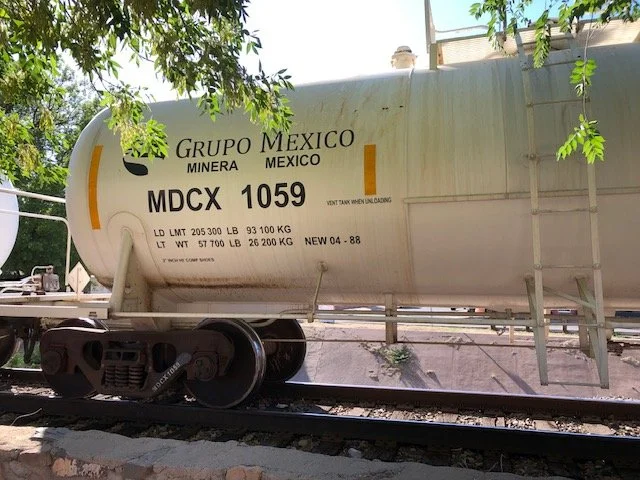Travel Dispatch Two ~~~ American Trains: Remnants, Functions, Absences
A guarantee to be had while traveling America is the train. Thousands of miles of tracks are archaeological digs waiting to happen in the future if that does. On hundreds of miles of back roads through Arizona, New Mexico and Colorado, a car I drove was in the middle of someone’s somewhere and as a new arrival here I felt like I was in the middle of nowhere, which I know wasn’t true. Train tracks told me so. On a new travel jaunt any morning, I would begin and a few miles into foreign roads I looked over.
Railroad ties strongly bound with steel tracks said herculean effort was a visitor at a time in the past. Parallel I drove to her record of intention. Gradually one tie was missing and then a steel track went astray, pinned an awkward misdirection and in a remote desert location the wind always brings sand to bury what is not used. The railroad track had disappeared. I saw this buried past wherever I drove along many miles during summer travels 2025.
Trains still function in what we call America today and in truthful history what are great swaths of land cultivated expertly through indigenous peoples’ culture. In her book An Indigenous Peoples History of the United States, author Roxanne Dunbar-Ortiz clarifies that “Native peoples had created town sites, farms, monumental earthworks, and networks of roads, and they had devised a wide variety of governments.” The “brave” Pilgrims and Puritans were entirely hapless when getting around as settler-colonizers. Ignoring established roads everywhere. First Peoples “conducted trade along roads that crisscrossed the land masses and waterways of the American continents.”
Point being that through mountains, valleys, riverbeds, sand dunes, and plains with no end on the distant horizon, I saw train tracks. Wishful thinking to see strategic placing of select tracks rather than watch historically how brutally dominating an ironclad colonizing one was through Native People’s and nature’s path. Having brought 140,000 miles of train tracks across Native Nation lands, what remains are functions, remnants, and absences of systemic trains.
In tony, functional downtown Flagstaff, Arizona I sat at a railroad crossing for ten minutes while a cargo train continued on her dutiful path cozily ignoring my impatience. Laughs I have for myself when I look in the mirror, seeing my modernity so clearly. Where was I going to go? Did I have a train to catch or what?
In Nogales, Arizona a massive train was lumbering along tracks mere walking distance from the motel. My enthusiasm for the oddity of trains can get the better of me so I kept my hustling sprint casual. While standing at the train tracks, what I saw was gargantuan effort to shuttle commodities from Nogales, Arizona to Nogales, Mexico and also the return voyage from Mexico to America, the two “countries” relying on each other as time immemorial land ecosystems will absolutely do when only a few sisterly miles away from each other.
A train traveling to Mexico from Arizona, a few sisterly miles away from each other on a shared land ecosystem.
A Mexican train on her familiar way.
Meanwhile train depots can be remnants. Like desert sand burying tracks no longer going anywhere, I have seen hundreds in dilapidated conditions, reminders that “civilization” was once here. One social dynamic I always see at an American train building no longer in use, or infrequently so, are people resting. Having the proximity and having been displaced through modern economics, our folks often gather and even try to stay here. A warm shelter, often times running water, even a lavatory, and this sequestered peacefulness. Questing folks often go to ancient train depots for respite.
Trains can function while commuting people, but only when a presence not an absence. One travel afternoon the journey had us arrive to downtown Los Angeles. At the Grammy Museum here (quite interactive for a “museum” and I highly recommend), we kept driving in vertical circles into a parking building ten stories high and occupying an entire city block. Paying $25 for a few hours to park we then stumbled onto wide urban streets for touristing. First, at a seriously upscale café I sat and paid $20 for a glass of water, a cup of coffee, and one croissant. Later, roaming a few avenues briefly, we strolled with Los Angelenos crowding the sidewalk festively.
The next afternoon another parking lot was Freeway 210 East. Crawling along at 15 to 20 miles per hour this pace had lasted an hour during 3 p.m. Los Angeles rush hour. Nobody was rushing though. Time and space for conversation was there, a spontaneous Mama’s teaching moment. Cue the lecturing, true—and be patient as well.
I asked our family teenager if he noticed what was missing during yesterday’s tourist travails. For the first time in several long days, he put his phone to the side.
“What?”
“Think about our tourist day yesterday. We paid $25 for a few hours of parking. Walked around for a while on spaciously wide urban streets.”
We had been in “conversation” several minutes and impatience was happening.
“I don’t know,” he said honestly. Yet wondering I was if tantrum clouds might appear on an otherwise blue-sky Southern California summer day. Or maybe a simplicity mindful moment.
“Hundreds of people walking around, thousands of expensive parking spaces. What did you not see?”
Darien stared out the window at traffic surrounding us every which way on a five-lane freeway where traffic had stalled to a stop again beginning the second hour going nowhere. He began to reach for his phone.
“Wait just a second before you go there,” I encouraged him. “Why do you think so much traffic is piling up here?”
“People have no other way to get around.”
“Right,” I congratulated him. “Los Angeles has no train system to help people commute. Remember buying a Firestone tire for our car a week ago? That company politically sabotaged Los Angeles city from building a train infrastructure. Car tires make money for Firestone. Public train systems do not.”
Maybe Darien had a sensibility that knowledge is powerful (how many times must I repeat the refrain? Oh, woe is me) because he began sending a flurry of texts. Probably he was the first to acquire this knowledge among his friends. Sharing now he was what he had learned. Texts flew to the techie coconut wireless where he lives for all his modern youth communication.
On the last evening of summer road tripping, we camped at southern California’s San Elijo State Park in Encinitas. Ironic laughs often feel the best. On a land tract stretching a while enough to accommodate 171 campsites (tents are passe so entirely Recreational Vehicles mostly) a few hundred feet away from the Pacific Ocean on one side and the functional, historical Pacific Coast Highway on the other, also a hundred feet away.
Cool summer wind was breezing in the 80s as a sky was shimmering with those orange, yellow, brown, grey, and red tints the sun brings at day’s end. I had a sense that the summer circling had been full and a thoughtful closure this campsite was. Being in the simplicity camp of life I had spent brief time putting up the two tents, air mattresses filled, blankets cozy, and sat at the picnic bench to enjoy high cuisine of ramen prepared with heated water on my camping stove. I still do. Camp. Outdoors. Who knew?
Ramen always goes better with an ironic laugh. I sat watching the ocean waves and the sun’s cascading colors, my back turned to PCH 1. And because the traveling goddess always enjoys a laugh, I heard a train rumbling. Close and turning around I saw several hundred feet away a short train, a few cargo cars pulling each other along, going north. Over the next few hours various trains commuted along—passenger and cargo ones. Despite American trains and their colonizing history, the mystery where one train goes and why does have intrigue. The one I heard as I contentedly dozed into rest for the evening was a long train that took 20 minutes to clear the tracks. Clackety clack, clack clack went the random train apparently going nowhere in the late night yet probably, really had somewhere to go with such purposeful travel.
San Elijo State Park beach environment, a few hundred feet from pitched tents at our campsite.



